In this chapter, we will cover the major components that almost all alarm systems have in common. By the end of the chapter you will realize that the so-called high tech alarm systems and access control systems are not really as complicated as some would like you to believe.
That said, let's get started.
Every alarm system in the world does two and only two basic things.
- It monitors the world around it. If the alarm is your neighbor's dog, it keeps an eye on trespassers. If it is an alarm system, then the central control panel monitors a bank of contacts (switches) and waits for something to change (just like the dog). These contacts are the output parts of various kinds of sensors. This is how the sensor tells the panel that something has changed. There are many kinds of sensors, about which I will tell you shortly, but they all signal the panel in much the same way.
- When the panel detects a change, it takes an appropriate action based on what the change was. It could be an alarm condition, or it could be a proper access control request. To use the dog scenario again, it could be you coming home from work, in which case the dog wags its tail. It could be the mailman, a bill collector, a burglar, or someone the dog doesn't know. In this case we have an alarm condition and the dog does its thing!
Note
Cool facts
It doesn't matter if it is the Bank of England or your cottage in Kent, the only major difference is how sophisticated (expensive) the sensors are and how fancy (expensive) the monitoring software is!
Also, I'm sure many of you have seen Tom Cruise drop from the ceiling to avoid the laser grid in Mission Impossible. You could have caught him with a $20 PIR motion sensor and saved yourself the price of the fancy lasers!
In my experience, you don't have to be an electrical engineer to install an alarm system, just a good carpenter, painter, and plasterer! By the way, I'm not, so I'll leave it up to you to hide the wires.
Also, because our alarm system runs on 12 volts, you don't have to be a licensed electrician to install it. If you can plug in a "wall wart" you are there! Fascinated yet? Read on….
And now, more on sensors and how they work.
The first sensor we will talk about is the door/window contact switch. This is by far the most common type of sensor used in the alarm industry. There are several variations of this sensor, but they all function in the same way. For example, you can buy a garage door sensor that has a large magnet and is physically large, so that when the wind sways your garage door, the rattling won't set off the alarm.
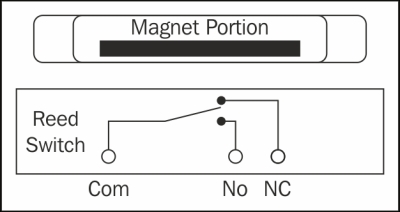
Typical door or window contacts
The preceding diagram shows a standard door or window sensor. Usually the contact position is when the reed switch is energized (the window is closed). If you aren't sure, check with an ohm meter.
The magnet normally holds the wiper of the reed switch against the normally closed contact. When the window or door is opened, the magnet can no longer hold the wiper against the normally closed contact and it opens.
You can think of a sensor as a magnetically operated single pole double throw (SPDT) switch. In fact, for testing purposes, you can use a toggle switch to simulate door and window contacts.
Remember what I said about carpentry?
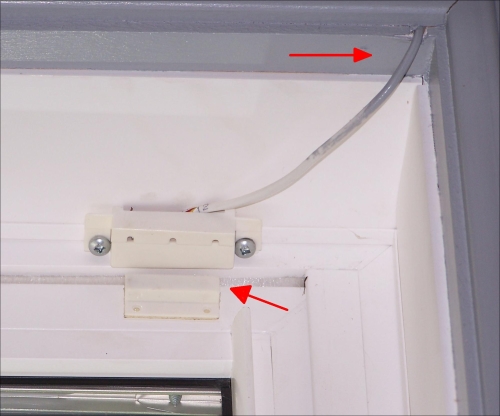
Installed window contacts
The preceding photograph is of an actual installation. The magnet (bottom arrow) is installed on the window, while the switch is on the window frame. The top arrow shows a poor installation job! The installer should have drilled a hole in the window frame closer to the switch, so that not much of the wire is exposed. The less exposed wire there is, the harder it is for the bad guys to bypass the switch. The same rule applies to all types of sensor installations.
The next most common sensor is the passive infrared motion sensor or PIR.
It is called a passive infrared sensor because it does not transmit anything. If, for example, it used an IR laser, it would be an active sensor. PIRs come in many shapes, sizes, and price ranges. Many of the more expensive models can be configured so that the family pet does not activate the sensor.
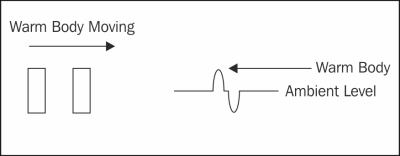
PIR motion sensing
A passive infrared sensor measures the ambient heat in the room and then waits for a warmer body to pass across its viewing area. The resulting "blip" in the ambience is what it detects.
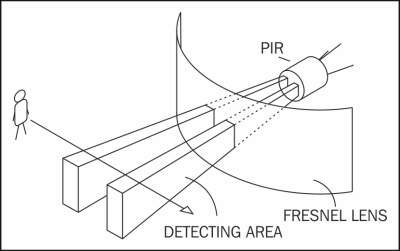
Fresnel lens
A Fresnel lens and a parabolic mirror are often used to extend the range of the sensor. Think of it as a flashlight in reverse. Instead of concentrating the light from the bulb into a beam, the ambient IR focuses on the sensor. In the preceding diagram, the mirror would be behind the Fresnel lens. The Fresnel lens acts like a camera lens to give the sensor a wider field of view. This is an extremely simplified explanation. Modern PIRs use digital signal processing to help eliminate false triggering. All you need to worry about is the field of view of the PIR, because that is what you will use when you install your PIRs. Most PIRs have about a 90 or 120 degree field of view. It is also possible to buy a PIR with a 360 degree field of view. This device looks like a dome, and mounts in the center of the room on the ceiling.
No matter how fancy the innards, in the end the result is a pair of contacts for your panel to read.
The next type of sensor that should be of interest to the reader is the glass break detector. This detector replaces the foil tape that you may have seen on the front windows of many stores. This tape was a pain to apply properly and depending on the climate, could dry out and crack.
Modern glass break detectors use a microphone, an amplifier, and digital signal processing to detect breaking glass.
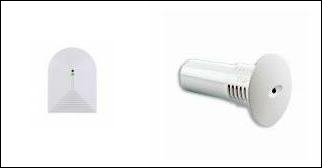
Typical glass break sensors
The sound of breaking glass is picked up by the microphone, amplified, and then filtered and detected by the software of the sensor.
Once again, the result is a set of contacts that open and close to indicate an alarm to your panel.

Glass break sensor block diagram
The final sensor of interest is the temperature rise sensor. This sensor is replacing the ionization type smoke detector in many modern buildings. Unlike a cheap ionization type of smoke detector, burning toast won't set it off! Much like the PIR and the glass break detector, it uses digital signal processing to sense a rapid rise in the ambient temperature, which would indicate a fire.
Also like the other detectors, it signals the panel by opening and closing a set of contacts.
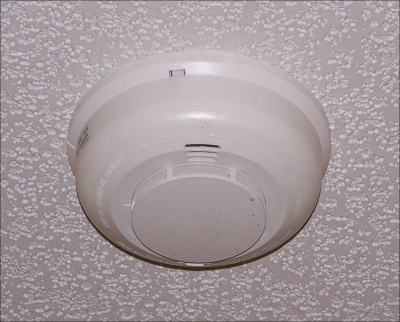
Heat rise sensor
